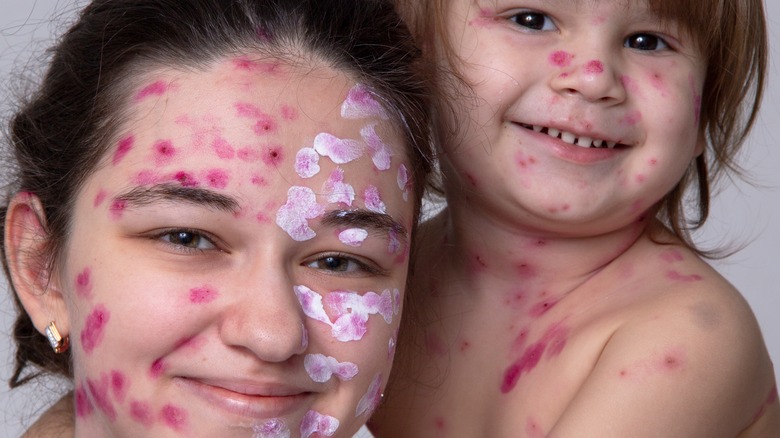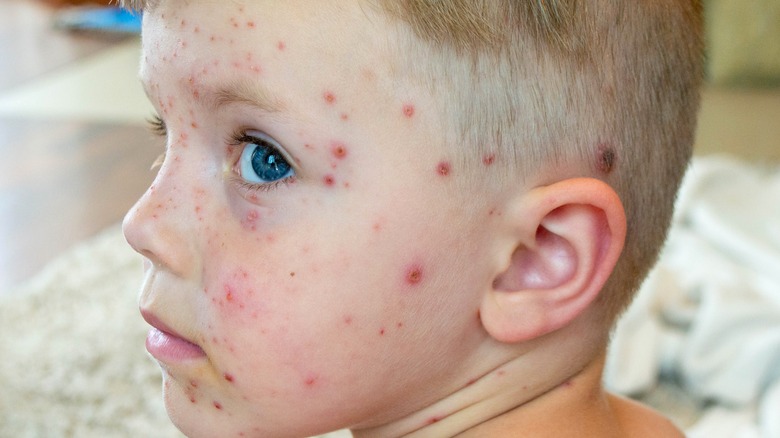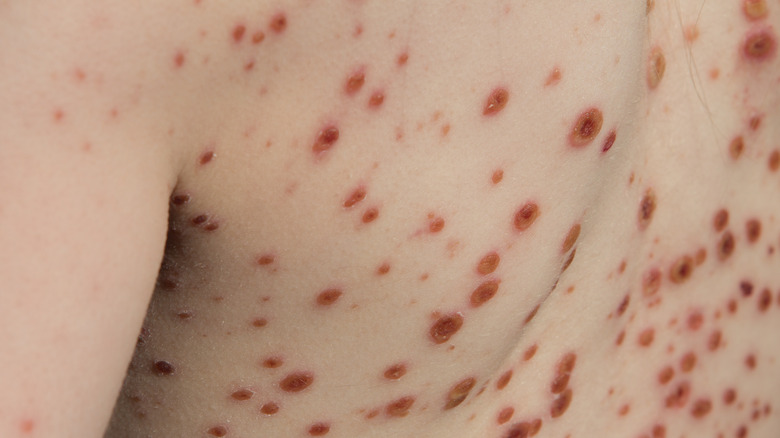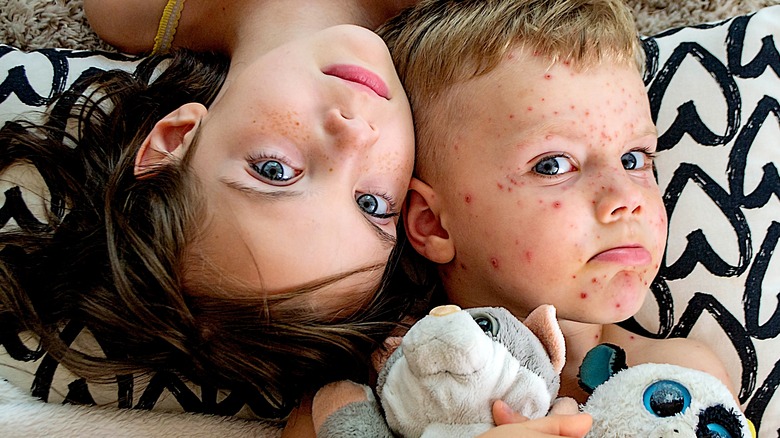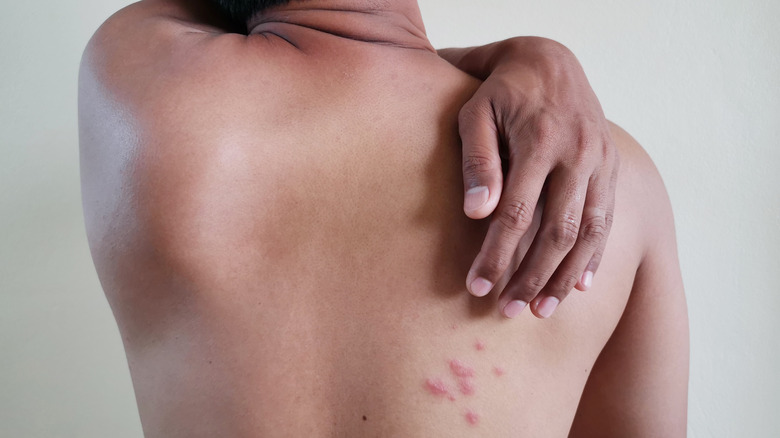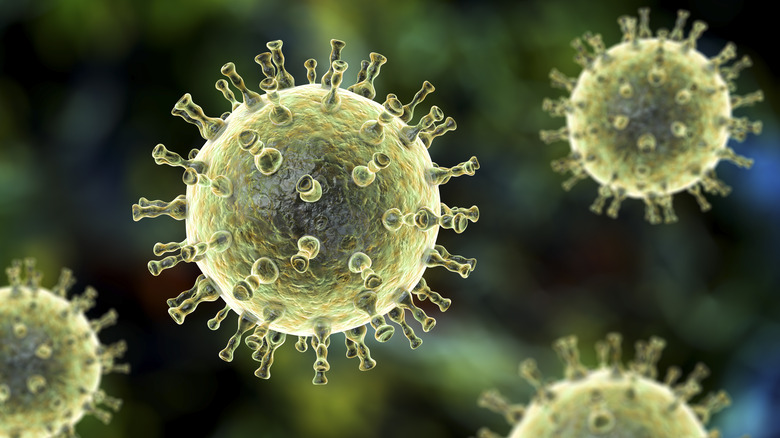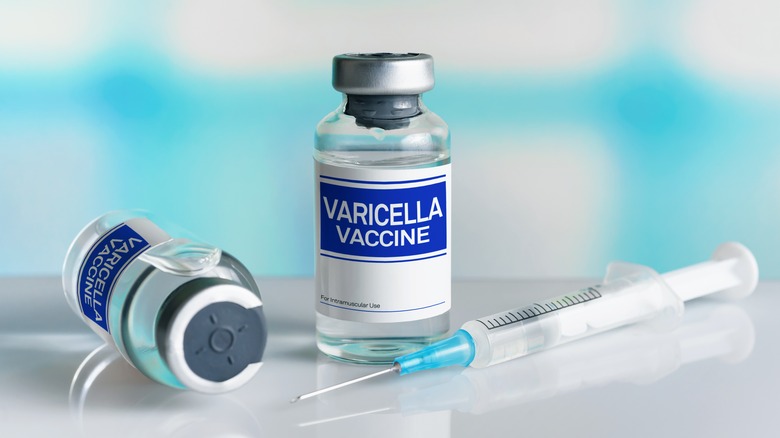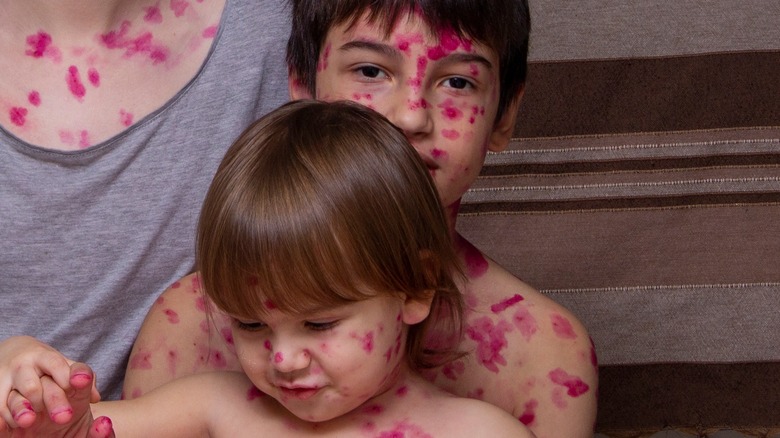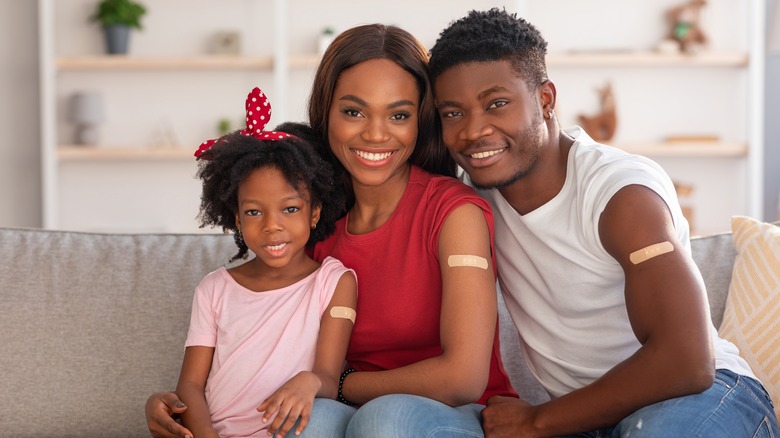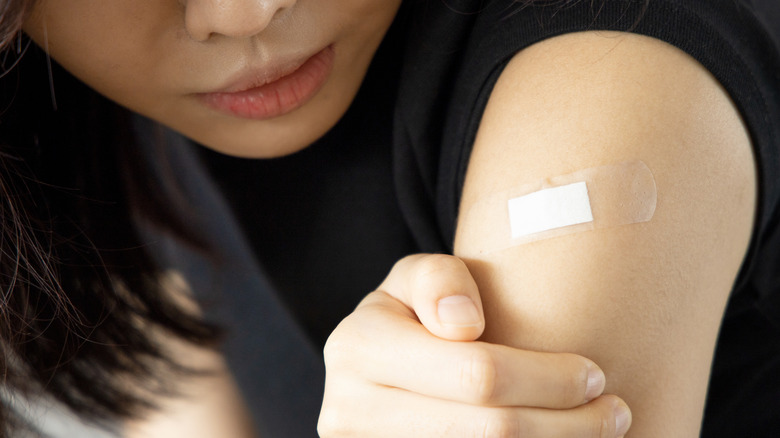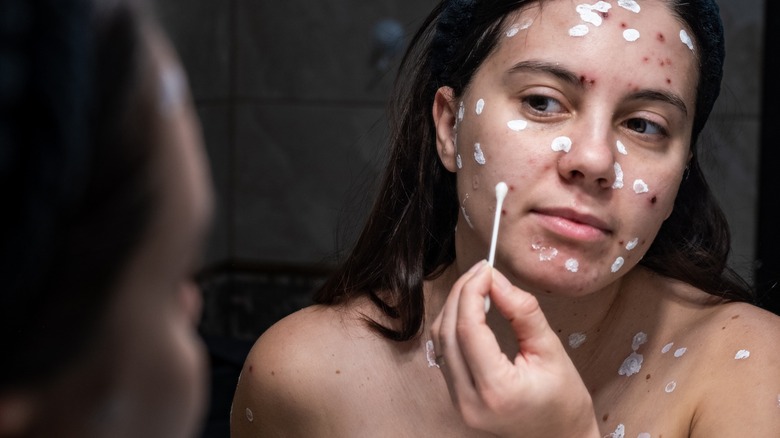Chickenpox Explained: Causes, Symptoms, And Treatments
The telltale signs of chickenpox are unmistakable: You know you're infected when itchy red spots start popping up on your face, back, or neck. They quickly spread all over your body, turning into oozing blisters. To say that it's not a pretty picture is an understatement — and it also means you're in for an itchy, uncomfortable week or two.
Brought about by the varicella-zoster virus — the same pathogenic virus responsible for shingles – chickenpox is highly contagious disease, according to the Centers for Disease Control and Prevention (CDC). Prior to the development of the vaccine, chickenpox was an extremely common ailment that spread quite easily. If one person got it, their entire household would, too. Although chickenpox is still mainly a childhood disease, anyone who's never had it or hasn't been vaccinated against it is at risk.
While there's no cure for chickenpox, there are preventative measures you can take to avoid getting and spreading it (per Medical News Today). Read on to learn how to identify chickenpox and tips for prevention and treatment.
Signs and symptoms of chickenpox
The symptoms of chickenpox start like typical cold or flu symptoms: Fever, fatigue, headache, loss of appetite, and stomachache (per Cleveland Clinic). Symptoms are generally milder in children than in adults.
After a couple of days, the classic symptoms of itchy red bumps start to appear on the body (per Healthline). The spots eventually turn into fluid-filled blisters. Once the blisters break and ooze, they begin to dry up, forming a crust and then scabs. It can take one to two weeks before the blisters turn into scabs and the skin to clear up.
According to the CDC, the rash typically starts on the chest, face, and back before reaching other parts of the body, including areas near the eyes, inside the mouth, and even on the genitals. Since the rash is so distinct, a chickenpox diagnosis is typically made by visually examining the blisters and skin (via Cleveland Clinic).
What complications can result from having chickenpox?
Besides having to endure a week or two of itchy red spots, most healthy people will recover from chickenpox without any complications. While there are some risks for complications, chickenpox is rarely fatal, according to the Cleveland Clinic. High-risk groups for complications from a severe case of chickenpox include infants, pregnant women, teenagers, anyone with a weakened immune system from an organ or bone marrow transplant, HIV, or cancer, and anyone receiving chemotherapy or steroid medication.
Serious but rare complications include bacterial infections of the skin, bones, blood (sepsis), and soft tissues such as muscles, nerves, and tendons (per Healthline). Other possible complications include blood clotting issues, dehydration, encephalitis (inflammation of the brain), pneumonia, and toxic shock syndrome.
Last but not least, children with chickenpox should not be given aspirin, as there is a chance of developing Reye's syndrome, which causes brain and liver damage.
How is chickenpox spread?
According to the CDC, "If one person has [chickenpox], up to 90% of the people close to that person who are not immune will also become infected." It takes up to three weeks to develop chickenpox after exposure to the virus. You are contagious 1 to 2 days before rashes appear, meaning you can unknowingly have chickenpox and inadvertently spread it.
An infected person ceases to be contagious when all their blisters have dried up and scabbed. If you have been vaccinated and have chickenpox, you are contagious until no new spots appear for a full day. If you have not had chickenpox or have not been vaccinated, you can catch it after spending as little as 15 minutes with an infected person (per Healthline). You can get it by breathing in air droplets or touching a surface contaminated by an infected person's breath, mucus, saliva, or blister fluid.
The chickenpox virus can also be spread by coming in close contact with someone who has shingles. Shingles is caused by the same virus that causes chickenpox (per CDC). If you have never had chickenpox or are unvaccinated, you should avoid coming in contact with the fluid from the shingles blisters. Likewise, if you have shingles, you should stay away from anyone who has not had chickenpox, is unvaccinated, or is in a high-risk group.
Can you get chickenpox more than once?
Since chickenpox spreads rather easily (and is thus easy to catch), you might be wondering if it's one of those diseases that can make things difficult for you more than once in your lifetime. Here's the bad news: it is indeed possible to get chickenpox more than once. The good news, however, is that it's unlikely to happen, according to Healthline.
You're at risk for getting chickenpox a second time if you had chickenpox within your first 6 months of life, if the first case was very mild, or if your immune system isn't in excellent shape. But chances are if you've been diagnosed with chickenpox twice, one of the cases was misdiagnosed (as some rashes are hard to distinguish from actual chickenpox).
More bad news, though: If you've had chickenpox, you could develop shingles. Once you've had chickenpox, the virus lies dormant in your nerve cells. If the virus is reactivated, it becomes shingles, a painful, blistery red rash that typically appears in a band on one side of the body.
The difference between chickenpox and shingles
The same virus (the varicella-zoster virus) causes both chickenpox and shingles, via Healthline. Chickenpox is typically considered a childhood disease, whereas shingles is typically seen in people over 60 years old. The symptoms are similar, but chickenpox causes itchy red bumps all over the body, whereas the shingles rash usually appears as a band or cluster of blisters on one side of the body or face.
You cannot get shingles if you have not had chickenpox before. Chickenpox is contagious, but shingles is not. This is where it gets a little confusing: You can get the chickenpox virus from someone who has shingles, but you can't get shingles from them. If you're exposed to someone with shingles and you've never had chickenpox or been vaccinated against it, you will get chickenpox, not shingles (per Healthline).
Preventative vaccines are available for both chickenpox and shingles. While vaccines are not 100% effective, they significantly reduce your risk of getting chickenpox and shingles. According to the CDC, if you get chickenpox after being vaccinated, your symptoms will be less serious than if you were exposed to the virus by an infected person. You'll also be sick for a shorter period. The same is true for the shingles vaccine (per CDC).
What vaccines are available to prevent chickenpox?
Before the chickenpox vaccine's introduction in 1995, the United States had about 4 million chickenpox cases, nearly 150 deaths, and over 10,000 hospitalizations yearly (per the CDC). Now, there are below 150,000 cases, less than 30 deaths, and fewer than 1,400 hospitalizations annually.
Per the CDC, there are two types of available chickenpox vaccines: ProQuad (MMRV) and Varivax (Varicella). Both vaccines are administered in two doses and are 98% effective in preventing chickenpox. According to Merck, the maker of both vaccines, ProQuad is a combination vaccine that protects against measles, mumps, rubella, and varicella, the chickenpox virus. This vaccine is used in children between 1 to 12 years old. Meanwhile, the Varivax vaccine protects against chickenpox only and is used in people 1 year and older.
The CDC recommends that children get their first dose of Varivax between 12 and 15 months of age. The second dose can be administered at least three months after the first dose, but is typically given between the ages of 4 and 6. For children receiving combination vaccines, the Advisory Committee on Immunization Practices recommends the following: The first dose should be the measles, mumps, and rubella (MMR) vaccine, with a separate varicella vaccine. The combination ProQuad vaccine, which protects against measles, mumps, rubella, and chickenpox, can be administered for the second dose (via Merck).
What are chickenpox parties?
You may have heard about parents attending "chickenpox parties" instead of getting their children vaccinated (per CNN Health). These gatherings are where healthy children are exposed to the chickenpox virus by playing with and coming in close contact with an infected child, with the goal of getting chickenpox and building up their immunity to the disease. There are many reasons why people choose to expose their children to the virus rather than get them vaccinated. Some people believe it's safer to get chickenpox as a child. Others believe the vaccine is unsafe or unnecessary, since you build immunity to chickenpox once you've had it.
Chickenpox parties were a common practice before the vaccine became available in 1995, but the CDC advises against them. Most children who get chickenpox will recover within a couple of weeks, but there's still a chance of developing dangerous complications like pneumonia or severe bacterial skin infections. Rather than getting chickenpox to build your immunity, the CDC recommends getting vaccinated. The vaccine will build up your immunity, and you can avoid developing severe complications.
Who should and should not get a chickenpox vaccine
According to the CDC, anyone who has never had chickenpox and has never been vaccinated should get a chickenpox vaccine. Children under 13 should get their first dose between 12 and 15 months of age and the second dose between 4 and 6 years of age. People 13 years and older should get their two doses at least 28 days apart. Getting vaccinated after you've been exposed to the chickenpox virus may prevent you from getting chickenpox if you're exposed to it again. If you get sick, the vaccine can help make the symptoms less severe.
The CDC says you should not get the chickenpox vaccine if you are allergic to any components in the vaccine (or if you had an allergic reaction to the first dose), pregnant or being treated for any condition that affects your immune system, receiving radiation treatments or blood products, or taking drugs that suppress your immune system. If you've been vaccinated against another disease, wait at least four weeks before getting the chickenpox vaccine.
Vaccines are available at pharmacies and your healthcare provider's office. Depending on your insurance plan, you may be able to get the chickenpox vaccine for little or no cost. If you don't have insurance coverage or your plan doesn't cover vaccines for children, you may be eligible for the Vaccines for Children Program (VFC). You can find information about your state's immunization program by visiting the CDC's immunization manager website.
Possible side effects from the chickenpox vaccine
The most common side effects of the MMRV and varicella vaccines are pain, redness, swelling at the injection site, and a mild fever (per CDC). For the MMRV vaccine, other sides effect may include swelling in the neck and cheek glands or temporary joint pain and stiffness. There's a risk of seizures for children who develop a fever after the first dose. A severe but rare reaction is unusual bleeding or bruising due to a temporary low platelet count.
For the varicella vaccine, severe but rare reactions include seizures, pneumonia, encephalitis (swelling of the brain), or meningitis (infection of the brain and spinal cord). If you develop a rash, stay away from anyone who hasn't been vaccinated (per CDC). With either vaccine, if you have experience any serious allergic reactions like hives, swelling of the face and throat, difficulty breathing or feeling dizzy or weak, call 911 or get to a hospital immediately.
Treatments for chickenpox
Unless you're in a high-risk group for complications, most cases of chickenpox can be treated at home (via Mayo Clinic). Your doctor may prescribe an antiviral drug such as acyclovir, famciclovir, or valacyclovir. These antivirals can help reduce the severity and duration of the illness, but need to be taken within 24 hours of getting the rash.
Try to avoid scratching the blisters, as this can spread the virus or cause a skin infection. If you do scratch a blister, wash your hand immediately with soap and water. To relieve itching, an antihistamine or a cool bath with baking soda or colloidal oatmeal can help. Use a cotton swab to dab calamine lotion on the spots, but don't double-dip the swab (to avoid contaminating the rest of the lotion). If you have a fever or body aches, acetaminophen and rest can relieve the fever and reduce discomfort.
If you're caring for a child with chickenpox, talk to their doctor before giving them any antihistamines. Try to keep them busy to take their mind off the itchiness, even if it means extra TV or screen time. Trim their fingernails to reduce their risk of skin infection. Never give a child or teenager with chickenpox aspirin, as it can lead to Reye's syndrome, a serious condition that can cause brain and liver damage. Use acetaminophen to treat a fever instead of ibuprofen, which has been linked to "life-threatening bacterial skin infections" in children with chickenpox (per CDC).

